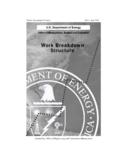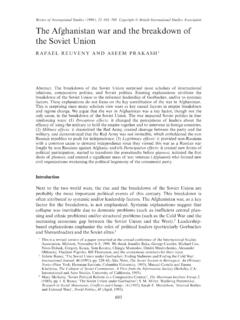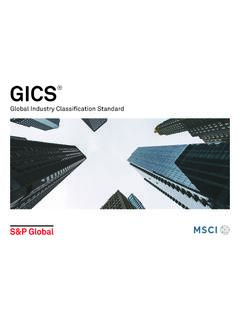Transcription of Offshore wind value breakdown 110920 - GOV.UK
1 [RAB (2010) 0365]. value breakdown for the Offshore wind sector A report commissioned by the Renewables Advisory Board February 2010. 1. value breakdown for the Offshore wind sector Contents 1. Introduction .. 3. 2. Background .. 3. 3. Definitions .. 4. 4. Typical Offshore wind CAPEX and OPEX .. 5. 5. Survey results .. 6. CAPEX .. 6. All CAPEX .. 6. Development and consent .. 7. Turbine excluding tower .. 9. Balance of plant .. 12. Installation and 14. OPEX .. 16. R&D .. 17. 6. 18. 7. Recommendations .. 18. Appendix: 20. 2. 1. Introduction This report for the Renewables Advisory Board (RAB) by BVG Associates presents the results of a short study into the costs of Offshore wind and the relative cost of labour, materials and other items expected in 2015.
2 The costs of Offshore wind have been split into the following five clearly defined categories, plus up to two levels of sub-categories under this: 1. Development and consent 2. Turbine excluding tower 3. Balance of plant 4. Installation and commissioning 5. Operation and maintenance Split of costs between the categories and sub categories and splits of labour, materials and other costs were given or derived from information provided by key industry players for their core area of activity at the request of DECC's UK Renewables Service. Where appropriate, these were combined and rationalised into the defined categories and sub-categories. It is important to note that the split of costs for projects constructed in 2015 (ie.)
3 Earliest Round 3. projects) will be different from existing wind farms. The categories which are expected to see the most change are: (A) Supply and installation of Offshore substations. Historically, Offshore wind farms have been of a relatively small capacity (typically 90MW) and close enough to onshore grid nodes that they have not needed Offshore substations. The first UK Offshore wind farm to have an Offshore substation was the 90MW Barrow Offshore wind farm which came online in 2006. In 2015, all new commercial wind farms will need Offshore substations and the breakdown presented here reflects this 2015 cost split. (B) Supply of foundations. To date, wind farms have been installed in water depths generally of less than 20m.
4 By 2015, average depths will be approaching 30m, with significant increase in cost. Note In addition that limited data seen for specific wind farms has noticeable variations due to many technical factors such as basic design parameters like water depth, tidal range, metocean conditions, wind farm and turbine size, distances to grid connection point, nature of grid connection and distance to construction port. Even more significant have been market factors of commodity prices, demand for turbines and other resources and risk allocation via contracting strategies. There are also costs whose levels the industry is still learning such as those for Operation and Management, where the basis for costs for turbines installed far from shore in 2015 could be quite different to today.
5 2. Background Offshore wind is expected to make the single biggest contribution to renewable energy generation in 2020 - the Renewable Energy Strategy (RES) Consultation projected 14 GW of installed Offshore wind UK capacity producing 47 TWh in 2020. Currently, UK Offshore sites with a combined capacity of 40 GW are being licensed. The Government is developing a range of measures to ensure that these levels of deployment can be achieved. The investment required by the market is substantial, covering a wide range of industries and services. Government is keen to see UK business benefit to the maximum extent from the opportunities, and to ensure that all elements of the supply chain develop in step to enable achievement of the deployment 3.
6 Targets. RAB wishes to support the Government programme by helping to quantify the magnitude of the investment that will be required and its breakdown into individual elements of the sector. 3. Definitions There are various forms of contracting the installation, operation and maintenance of wind farms and these treat the supply of hardware and services differently, in some cases hiding the true allocation of cost. As examples, cost and risk allocation between the supply and installation elements of an EPC contract is not visible to the wind farm developer and OPEX for the initial years of a wind farm often cannot be separated from CAPEX payments made to a turbine manufacture as part of a warranty agreement.
7 Strict definitions of the categories of costs of an Offshore wind farm were applied here to best ensure the relative split between categories was consistent. Frequently in dialogue, however, interviewees were not themselves sure of the categorisation. These categories are as follows: Development and consenting includes the multifaceted process of taking a wind farm from inception through to the point of financial close or commitment to build, depending on the contracting model, including Environmental Impact Assessment, planning, FEED studies and contract negotiation. Turbine excluding tower includes supply of all components (including turbine transformers). upwards from (but excluding) the transition piece/foundation and in this case also excluding the tower structure .
8 This includes delivery to a port (which may not be the port used for storage and pre-assembly of components before transfer to the wind farm site). Balance of plant (BoP) includes detailed infrastructure design and supply of all parts of the wind farm except turbines, including tower, foundations, buildings, electrical systems between turbine and the onshore demarcation point between the wind farm and grid. Conventionally, the tower is seen as part of the scope of supply of the turbine. In this case, due to the synergies of manufacture of the tower and typical steel foundation, it has been incorporated here. Installation and commissioning includes installation of turbines and balance of plant on site and commissioning of these to a fully operational state, up to point of issue of any take over certificate.
9 Operation and maintenance (O&M) starts from take-over, on completion of building and commissioning of all or part of a wind farm. It includes servicing of turbines and other parts including electrical grid connection. Whilst it does include insurance for the replacement of faulty/broken components or defective work it does not include coverage of this by warranties. In addition, the following definitions are used: Capital Expenditure (CAPEX) includes all one-time expenditure associated with wind farm development, deployment and commissioning up to the point of issue of a takeover certificate. Operating Expenditure (OPEX) includes all expenditure occurring from immediately after point of takeover, whether one-time or recurring, related to the wind farm, measured on an annual basis.
10 Excluded are expenses inherent to the operation of the operators business but not directly related to the operation and management of the wind farm. Grid connection includes the dedicated cables and other costs associated with connecting the wind farm to the National Grid, including any isolators and switchgear under the control of the onshore network operator. 4. Warranty means a provision in contracts funded by CAPEX for the replacement of faulty/broken components or defective work, plus any agreed reimbursement due to consequent loss of revenue, usually for initial fixed periods which may vary for different elements. Labour means direct & indirect labour, including UK office staff and supply chain staff contribution that could be realistically be in the UK given appropriate industry and market conditions.
















